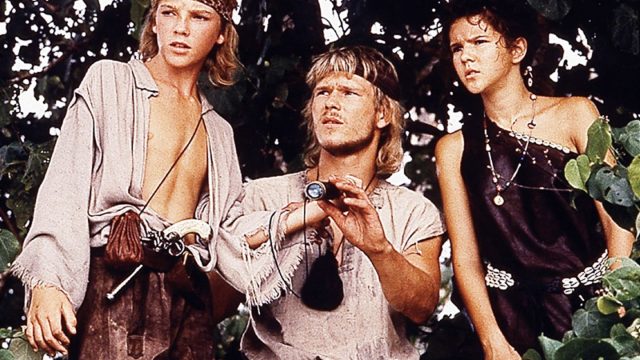This movie in fact appears to have been made in 1990 and had its Norwegian release then but released in the US in 1991. The Norwegian release was, shockingly, mostly in Norwegian; the English characters spoke English, and the Norwegian characters spoke English to them, but they spoke Norwegian to one another. It seems the dubbing was mostly done by the original actors. I remember this being shown on The Disney Channel when I was a kid, but I never watched it then and have watched it for the first time just now.
Haakon Haakonsen (Stian Smestad) is a sailor’s son from Norway. His father (Bjørn Sundquist) was believed lost at sea, but he’s returned to the family farm—with a commission for Haakon to be ship’s boy on his ship. Since the father was injured at sea, either Haakon takes it or the family loses the farm. So off to sea Haakon goes. He befriends Jens (Trond Peter Stamsø Munch), the sailor who saved his father’s life. What we the audience know and the sailors don’t is that the “British Navy” sailor who has come aboard as first mate has in fact murdered the real “Howell” and is in reality John Merrick (Gabriel Byrne).
Why does the plot involve the British Navy, a trip to Sydney, and a Plucky Australian OrphanTM? Goodness knows. Certainly I do not. Although I’d originally believed the story to be by Robert Louis Stevenson, it is not. It is by Oluf Falck-Ytter and based on a book called Haakon Haskonsen: A Norwegian Robinson. It’s yet another story inspired by Robinson Crusoe, which I suppose might be why there’s a fair amount of English/colonial content involved. I do like the character of Mary (Louisa Milwood-Haigh) well enough, but I have no idea what she’s actually doing relevant to the story.
It’s filmed well enough. The music is by Patrick Doyle, who’s worked a lot with Kenneth Branagh and done a few other Disney movies. In fact, his first movie was Branagh’s Henry V, just a year earlier. He hasn’t quite worked out his bombast yet, and the music can be a little overwhelming. The actual filming has the benefit of being mostly either at sea or on a tropical island, meaning you’ve got a lot of sweeping vistas and glorious sunsets and things to work with; if you can’t make some of these shots beautiful, you’re just not trying.
I’ve got a certain amount of disdain for Haakon’s father, bluntly. The family relies on both a farm and his presumed wages as a sailor, and they’re losing the farm. Either his fourteen-year-old son goes to sea—Smestad’s only about nine months older than I am, and I was in junior high at the time—or the family loses its home. If Haakon hadn’t found what he did, the family would lose it at the end. (No spoilers beyond that detail.) If the father were dead, fine, given the story’s set in the 1850s. But he’s not. He’s just a rotten provider.
One thing I really liked about the movie was the fact that booby traps fail. Usually, movie booby traps work perfectly forever—apparently, someone in all those ancient tombs is going around testing and oiling and so forth. It turns out in this that vines continue growing on tropical islands even when the growth gets in the way of a booby trap. I support this. Even if it makes things more difficult for Haakon.
Help me support my own family by contributing to my Patreon or Ko-fi!

